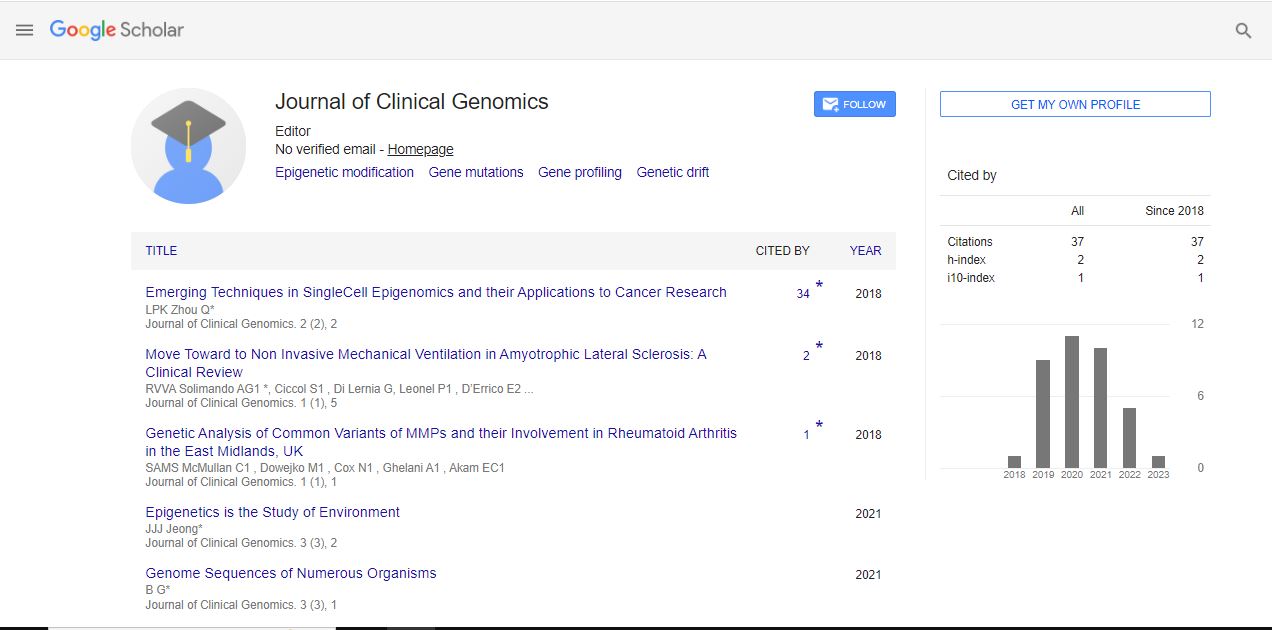Opinion Article, J Chromatography Res Vol: 6 Issue: 4
Revolutionizing Separations: Cutting-Edge Column Technologies in Chromatography
Victor Hendrik*
1Department of Pharmaceutical Chemistry and Drug Analysis, Center for Neurosciences,Brussels, Belgium
*Corresponding Author: Victor Hendrik,
Department of Pharmaceutical Chemistry
and Drug Analysis, Center for Neurosciences,Brussels, Belgium
E-mail: Hendrikvan_i23@gmail.com
Received date: 27 November, 2023, Manuscript No. JCGR-24-123805;
Editor assigned date: 29 November, 2023, Pre QC No. JCGR-24-123805 (PQ);
Reviewed date: 14 December, 2023, QC No. JCGR-24-123805;
Revised date: 21 December, 2023, Manuscript No. JCGR-24-123805 (R);
Published date: 28 December, 2023, DOI: 10.36648/JCGR.1000075.
Citation: Hendrik V (2023) Revolutionizing Separations: Cutting-Edge Column Technologies in Chromatography. J Chromatography Res 6:4.
Description
Chromatography, a fundamental technique in analytical chemistry, relies on the separation of components in a mixture based on their interactions with a stationary phase and a mobile phase. The heart of chromatography lies in the chromatographic column, which plays a pivotal role in determining the efficiency, selectivity, and speed of the separation process. Recent years have witnessed remarkable advances in column technologies, driven by innovations in materials, design, and manufacturing processes. This essay explores the key developments in column technologies across various chromatographic techniques, highlighting their impact on analytical performance and applications.
High-Performance Liquid Chromatography (HPLC) columns
One of the significant advancements in HPLC column technology is the development of novel particle technologies. Traditional fully porous particles have given way to Superficially Porous Particles (SPP) or core-shell particles. SPP offer a unique compromise between efficiency and backpressure, resulting in improved resolution and faster separations. The reduction in particle size and the introduction of sub-2 particles have also contributed to enhanced efficiency and resolution. Monolithic columns represent a departure from the traditional packed columns. These columns consist of a single, continuous piece of stationary phase, providing rapid mass transfer and minimal backpressure. Monoliths exhibit excellent separation efficiency and are particularly advantageous in high-speed, highthroughput applications.
Porous Layer Open Tubular (PLOT) columns, initially popular in gas chromatography, have found applications in HPLC as well. These columns possess a thin, porous layer on the inner surface of the column, improving mass transfer and allowing for efficient separations of complex samples, such as proteins and peptides. Microfabrication techniques have been applied to Gas Chromatography (GC) columns, resulting in miniaturized columns with reduced internal diameters. Microfabricated columns enhance resolution and speed while reducing the consumption of carrier gas. These columns are particularly advantageous for portable GC systems. Advancements in stationary phase coatings have significantly improved the selectivity and versatility of GC columns. Functionalized phases, such as Polyethylene Glycol (PEG) and ionic liquids, enable tailored separations for specific compound classes, expanding the applicability of GC in various industries.
Capillary Electrophoresis (CE) are coating of capillaries with specialized materials has advanced CE separations. Capillaries coated with polymers or surfactants can alter the electroosmotic flow, enhancing the separation of charged analytes. These coatings improve resolution and minimize analyte interactions with the capillary wall. Similar to monolithic columns in HPLC, monolithic capillaries in CE offer advantages in terms of speed and efficiency. The continuous porous structure of monolithic capillaries promotes rapid mass transfer and provides excellent separation performance for a wide range of analytes.
In both HPLC and GC, the development of immobilized Chiral Stationary Phases (CSPs) has significantly improved the separation of enantiomers. These stationary phases are anchored to the column, ensuring stability and reproducibility. Immobilized CSPs contribute to the analysis of chiral compounds in pharmaceuticals, agrochemicals, and food products.
Molecularly Imprinted Polymers (MIPs) represent a novel class of stationary phases designed with specific binding sites for target molecules. These synthetic polymers are imprinted with the template molecule during their synthesis, resulting in high selectivity for the target analyte. MIPs have found applications in various chromatographic techniques, providing tailor-made solutions for complex sample matrices.
Multidimensional chromatography involves the coupling of multiple columns with different selectivities, enhancing separation power. Comprehensive Two-Dimensional Gas Chromatography (GCxGC) and Two-Dimensional Liquid Chromatography (LCxLC) have become powerful tools for complex sample analysis. The combination of different column chemistries enables the separation of a broader range of compounds and provides a more comprehensive understanding of complex mixtures.
The integration of Solid-Phase Extraction (SPE) with LC columns has streamlined sample preparation and analysis. Online SPE-LC systems allow for direct extraction of analytes from complex matrices onto a solid-phase, followed by elution and separation on the analytical column. This approach enhances sensitivity and reduces sample handling steps. Advances in column technologies have synergized with hyphenated techniques, such as Liquid Chromatography-Mass Spectrometry (LC-MS) and Gas Chromatography-Mass Spectrometry (GC-MS). The integration of high-performance columns with sophisticated mass spectrometric detection provides enhanced sensitivity, selectivity, and identification capabilities.
As environmental consciousness grows, there is a concerted effort to develop sustainable column technologies. Columns made from biodegradable or recyclable materials, as well as efforts to reduce solvent consumption and waste generation, contribute to more environmentally friendly chromatographic practices.
Advancements in column technologies have transformed chromatography into a highly sophisticated and versatile analytical tool. The development of novel particle technologies, monolithic columns, and coated capillaries has elevated separation efficiency and speed. Innovations in stationary phase chemistry, including immobilized CSPs and MIPs, have enabled highly selective separations. The emergence of multidimensional chromatography and online SPE-LC systems has provided comprehensive solutions for complex sample analysis. Coupled with hyphenated techniques, these advances in column technologies continue to drive the evolution of chromatography, shaping its future as a cornerstone of analytical chemistry.
 Spanish
Spanish  Chinese
Chinese  Russian
Russian  German
German  French
French  Japanese
Japanese  Portuguese
Portuguese  Hindi
Hindi 